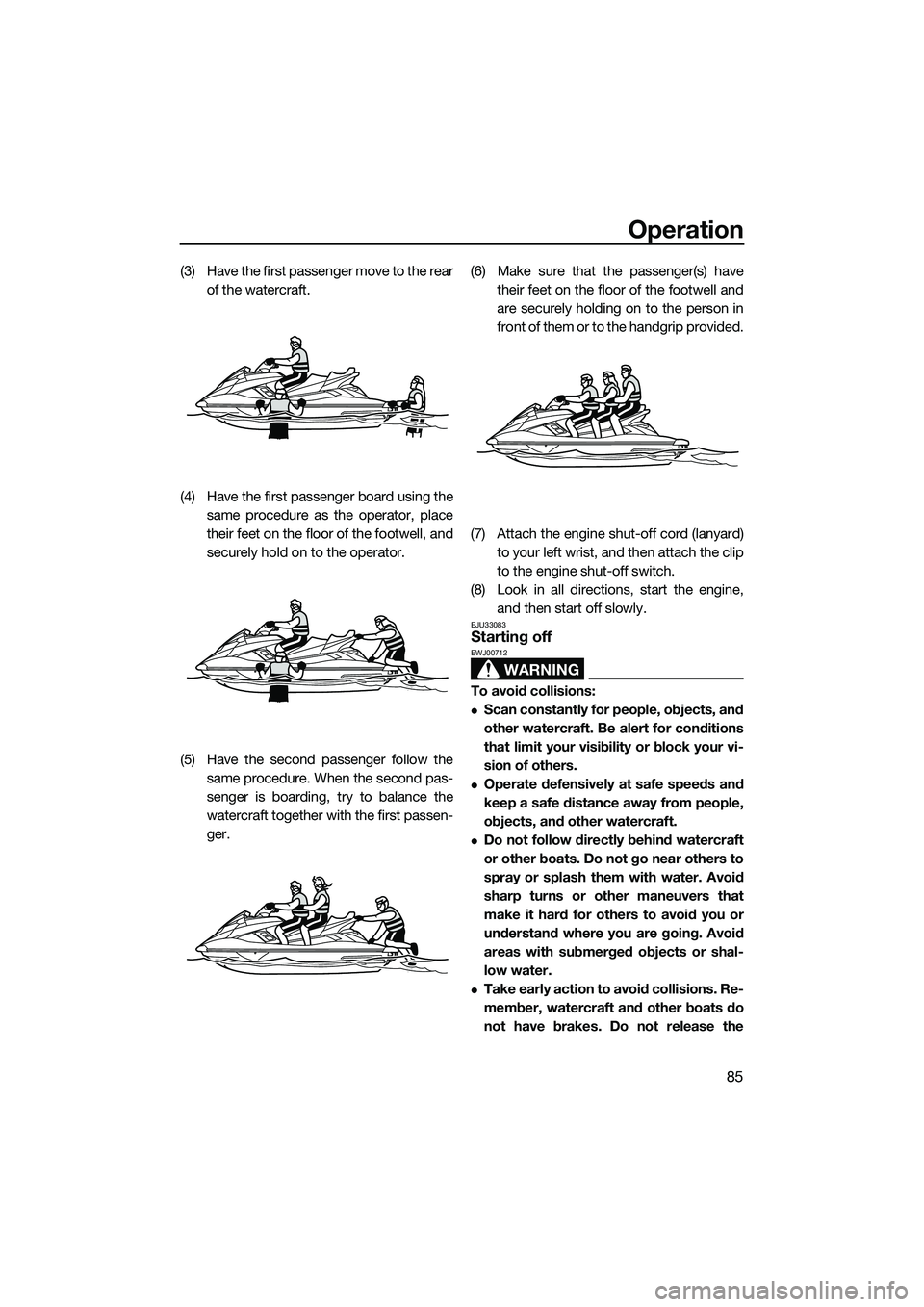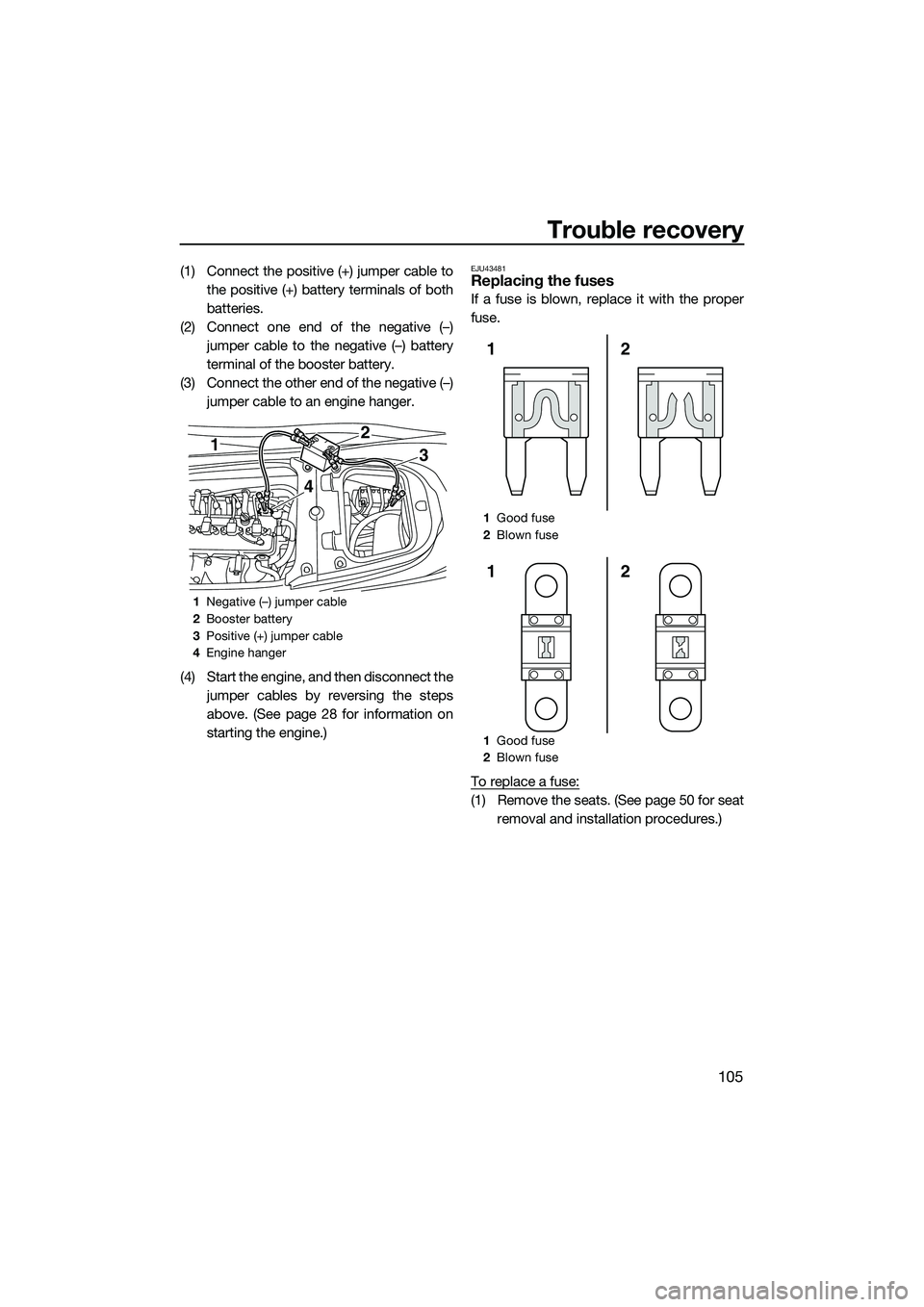2015 YAMAHA FX SVHO starting procedure
[x] Cancel search: starting procedurePage 6 of 118

Table of contents
Transporting on a trailer ................ 64
First-time operation ........................ 65 Engine break-in ............................. 65
Pre-operation checks ..................... 66
Pre-operation checklist .................... 66
Pre-operation check points........... 68
Pre-launch checks ........................... 68
Post-launch checks ......................... 74
Operation ......................................... 77 Operating your watercraft ............. 77
Getting to know your watercraft ...... 77
Learning to operate your
watercraft ...................................... 77
Riding position ................................. 78
Launching the watercraft ................. 78
Starting the engine on water ............ 78
Stopping the engine ......................... 79
Leaving the watercraft...................... 79
Operating the watercraft .................. 79
Turning the watercraft ...................... 80
Stopping the watercraft ................... 81
Operating the watercraft in reverse or neutral....................................... 82
Boarding the watercraft ................... 83
Starting off........................................ 85
Capsized watercraft ......................... 86
Beaching and docking the
watercraft ...................................... 87
Operating in weeded areas .............. 87
After removing the watercraft from the water ....................................... 87
Care and storage............................. 89Post-operation care ...................... 89
Flushing the cooling water
passages....................................... 89
Cleaning the watercraft .................... 90
Battery care ...................................... 90
Long-term storage ........................ 93
Cleaning ........................................... 93
Lubrication ....................................... 93 Rustproofing ..................................... 93
Maintenance .................................... 94
Maintenance ................................. 94
Tool kit.............................................. 94
Removing and installing the engine
cover ............................................. 94
Periodic maintenance chart ............. 96
Engine oil and oil filter ...................... 98
Specifications .................................. 99 Specifications ............................... 99
Trouble recovery ........................... 100 Troubleshooting .......................... 100
Troubleshooting chart .................... 100
Emergency procedures .............. 103
Cleaning the jet intake and
impeller ....................................... 103
Raising the reverse gate................. 104
Jumping the battery ....................... 104
Replacing the fuses ........................ 105
Towing the watercraft..................... 107
Submerged watercraft ................... 107
Index............................................... 109
UF3J71E0.book Page 2 Friday, June 27, 2014 1:50 PM
Page 91 of 118

Operation
85
(3) Have the first passenger move to the rearof the watercraft.
(4) Have the first passenger board using the same procedure as the operator, place
their feet on the floor of the footwell, and
securely hold on to the operator.
(5) Have the second passenger follow the same procedure. When the second pas-
senger is boarding, try to balance the
watercraft together with the first passen-
ger. (6) Make sure that the passenger(s) have
their feet on the floor of the footwell and
are securely holding on to the person in
front of them or to the handgrip provided.
(7) Attach the engine shut-off cord (lanyard) to your left wrist, and then attach the clip
to the engine shut-off switch.
(8) Look in all directions, start the engine, and then start off slowly.
EJU33083Starting off
WARNING
EWJ00712
To avoid collisions:
Scan constantly for people, objects, and
other watercraft. Be alert for conditions
that limit your visibility or block your vi-
sion of others.
Operate defensively at safe speeds and
keep a safe distance away from people,
objects, and other watercraft.
Do not follow directly behind watercraft
or other boats. Do not go near others to
spray or splash them with water. Avoid
sharp turns or other maneuvers that
make it hard for others to avoid you or
understand where you are going. Avoid
areas with submerged objects or shal-
low water.
Take early action to avoid collisions. Re-
member, watercraft and other boats do
not have brakes. Do not release the
UF3J71E0.book Page 85 Friday, June 27, 2014 1:50 PM
Page 92 of 118

Operation
86
throttle lever when trying to steer away
from objects—you need throttle to
steer.
NOTICE
ECJ01341
Never run the engine in water that is less
than 60 cm (2 ft) deep from the bottom of
the watercraft, otherwise pebbles or sand
could be sucked into the jet intake, caus-
ing impeller damage and engine overheat-
ing.
EJU43271Starting off from a trailer
(1) Launch the watercraft.
(2) Attach the engine shut-off cord (lanyard)to your left wrist, and then attach the clip
to the engine shut-off switch.
(3) Look in all directions, and then start the engine.
(4) Squeeze the RiDE lever and move the watercraft back slowly. (See page 32 for
RiDE lever operation procedures.)
EJU33114Boarding and starting off from a dock
(1) Board the watercraft from the side.
(2) Attach the engine shut-off cord (lanyard)to your left wrist, and then attach the clip
to the engine shut-off switch.
(3) Push the watercraft away from the dock, grip the handlebars with both hands, and place both feet on the floor of the foot-
well.
(4) Look in all directions, start the engine, and then start off slowly.
EJU33236Capsized watercraft
WARNING
EWJ00672
Improper uprighting can cause injury.
Be sure to shut the engine off by pulling
on the engine shut-off cord (lanyard) to
remove the clip from the engine shut-off
switch.
Do not put your hands in the intake
grate.
If the watercraft capsizes, turn it over imme-
diately.
To upright the watercraft:
(1) Remove the clip from the engine shut-offswitch.
(2) Swim to the rear of the watercraft. Turn the watercraft over clockwise by pulling
on the ride plate with your left hand while
pushing down on the gunwale with your
right hand or foot.
If the port (left) side of the capsized wa-
tercraft is tilting up, push down on the
gunwale so that the port (left) side is
down before turning the watercraft
clockwise. NOTICE: Do not turn the
watercraft over counterclockwise,
UF3J71E0.book Page 86 Friday, June 27, 2014 1:50 PM
Page 99 of 118

Care and storage
93
EJU33493
Long-term storage
WARNING
EWJ00331
Always place the watercraft upright in a
horizontal position when storing it, other-
wise fuel could leak out into the engine or
engine compartment, which could create
a fire hazard.
Storage for long periods of time, such as win-
ter storage, requires preventive maintenance
to ensure against deterioration. It is advisable
to have the watercraft serviced by a Yamaha
dealer prior to storage.
However, the following procedures can be
performed easily by the owner.
EJU40763Cleaning
(1) Flush the cooling water passages. (Seepage 89 for information on flushing the
cooling water passages.)
TIP:
If you will be storing the watercraft for a pro-
longed period, such as winter storage, top off
the fuel tank with fresh gasoline and add fuel
stabilizer and conditioner to the fuel tank ac-
cording to the manufacturer’s instruction be-
fore starting the engine.
(2) Clean the watercraft. (See page 90 for in-formation on cleaning the watercraft.)
Wax the hull with a non-abrasive wax.
EJU43301Lubrication
Use a suitable marine grease applicator and
spray a rust inhibitor between the inner and
outer cables to lubricate the cables and
purge out any dirt and moisture.
To keep moving parts sliding or rotating
smoothly, lubricate them with water-resistant
grease.
Steering cable (jet thrust nozzle end) and
electric trim rod (jet thrust nozzle end)
Shift rod (reverse gate end)
EJU40812Rustproofing
Spray metallic parts of the hull, deck, and en-
gine with a rust inhibitor.
Have a Yamaha dealer rustproof the internal
engine components.Recommended water-resistant grease:
Yamaha Marine Grease/Yamaha
Grease A
UF3J71E0.book Page 93 Friday, June 27, 2014 1:50 PM
Page 111 of 118

Trouble recovery
105
(1) Connect the positive (+) jumper cable tothe positive (+) battery terminals of both
batteries.
(2) Connect one end of the negative (–) jumper cable to the negative (–) battery
terminal of the booster battery.
(3) Connect the other end of the negative (–) jumper cable to an engine hanger.
(4) Start the engine, and then disconnect the jumper cables by reversing the steps
above. (See page 28 for information on
starting the engine.)EJU43481Replacing the fuses
If a fuse is blown, replace it with the proper
fuse.
To replace a fuse:
(1) Remove the seats. (See page 50 for seatremoval and installation procedures.)
1Negative (–) jumper cable
2 Booster battery
3 Positive (+) jumper cable
4 Engine hanger
1
4
3
2
1Good fuse
2 Blown fuse
1 Good fuse
2 Blown fuse
2
1
2
1
UF3J71E0.book Page 105 Friday, June 27, 2014 1:50 PM
Page 115 of 118

109
Index
A
Adjustable tilt steering system ................. 30
Adjustable tilt steering system checks .... 71
After removing the watercraft from the water ..................................................... 87
Analog speedometer/tachometer ............ 40
B
Battery care.............................................. 90
Battery checks ......................................... 69
Battery, jumping ..................................... 104
Beaching and docking the watercraft ...... 87
Beverage holders ..................................... 56
Bilge water check..................................... 69
Bilge water, draining ................................ 63
Bilge water, draining on land ................... 63
Bilge water, draining on water ................. 63
Boarding alone ......................................... 83
Boarding and starting off from a dock ..... 86
Boarding the watercraft ........................... 83
Boarding with passenger(s) ..................... 84
Bow eye ................................................... 52
Bow storage compartment ...................... 53
Builder’s plate ............................................ 2
C
Capsized watercraft ................................. 86
Check engine warning ............................. 45
Cleaning ................................................... 93
Cleaning the watercraft ............................ 90
Cleat ......................................................... 52
Cooling water pilot outlet check .............. 74
Cooling water pilot outlets ....................... 31
Craft Identification Number (CIN)............... 1
Cruise assist............................................. 38
Cruising limitations................................... 12
D
Digital speedometer ................................. 41
E
Electric trim system.................................. 34
Emergency procedures .......................... 103
Engine break-in ........................................ 65
Engine compartment check ..................... 68
Engine cover, removing and installing ..... 94
Engine idling speed check ....................... 76
Engine oil ................................................. 61
Engine oil and oil filter .............................. 98 Engine oil level check ............................... 69
Engine oil requirements ........................... 61
Engine overheat warning.......................... 44
Engine serial number ................................. 1
Engine shut-off cord (lanyard) check ....... 72
Engine shut-off switch ............................. 28
Engine stop switch ................................... 28
Engine unit check ..................................... 69
Enjoy your watercraft responsibly ............ 20
Equipment ................................................ 50
F
Fire extinguisher check ............................ 73
Fire extinguisher holder and cover........... 58
Fire extinguisher holder, cover, and
band checks ......................................... 73
Flushing the cooling water passages....... 89
Fuel .......................................................... 59
Fuel level check........................................ 68
Fuel level meter ........................................ 43
Fuel level warning..................................... 44
Fuel requirements .................................... 59
Fuel system checks ................................. 68
Fuses, replacing ..................................... 105
G
Getting to know your watercraft .............. 77
Glossary, watercraft ................................. 21
Glove compartment ................................. 54
H
Handgrip .................................................. 51
Hazard information................................... 16
Hood check .............................................. 74
Hour meter/voltmeter ............................... 42
Hull and deck check ................................ 73
I
Identification numbers ............................... 1
Information display................................... 41
J
Jet intake and impeller, cleaning............ 103
Jet intake checks ..................................... 73
Jet thrust nozzle and reverse gate check .................................................... 73
Jumper cables, connecting .................... 104
L
Labels, important ....................................... 4
Labels, other .............................................. 9
UF3J71E0.book Page 109 Friday, June 27, 2014 1:50 PM